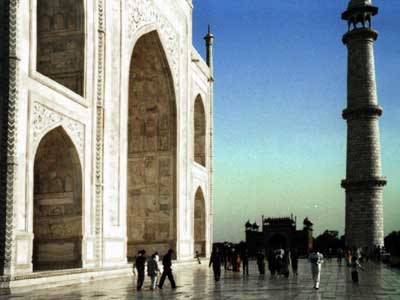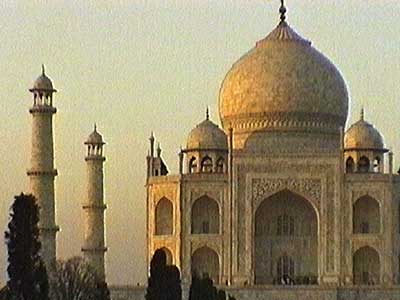AGRA (Day 8)
We got up early and started our drive to Agra, some 140 miles away. The scenery became much greener as we continued our drive east. No longer did sand drift its way over the road but rather lush crops stretched as far as the eye could see. There was still the occasional camel to be seen (including one large dead one in the road), but they were slowly being replaced by more and more water buffalo.
On the way we stopped at Fatehpur Sikri, the abandoned city. It is the remains of the old capital of the province from 1570 - 1586 under the third Great Mughal Akbar (1556 - 1605) who eventually had to move to Agra (26 miles away) because of constant water shortages.
We parked and walked up the long path lined with all sorts of vendors to the main entrance. We took off our shoes and were expected to pay in order to leave them outside, but eventually we figured out we could just carry them with us for free. We entered the enormous red courtyard and were accosted from all sides. One group of people wanted us to take a photo WITH them (apparently this is quite common). We were followed for quite a while by a 12-year-old boy claiming to be there for his school who wanted to give us a 'free' tour. We were suspicious. Finally he confessed that all he wished for us to do was visit his family's store just outside the gate. So we agreed.
He spoke about as quickly as he walked, and we literally ran from one site to another, which mind you, wasn't easy given the fact that the ground was covered with hundreds upon hundreds of dead or dying bees... and we were just in our socks. He seemed to have no problems though. We first went to a small tomb area before heading over to the famous white tomb of Akbar himself. We had to take turns going inside since our shoes weren't allowed. Inside, was the small square tomb in the center. People tied strings for luck on the carved white marble outer screen walls; these were Akbar's wishing screens. While it was my turn to wait, I was hassled constantly... people wanting my hat, a pen, anything.

A floor of tombs

Emperor Akbar's white tomb. People come from miles around to tie a string on it for good luck.
We were then scooted to the Dargah Mosque with its vaulted ceiling almost ready to collapse under the simply enormous beehives that hung from it. Akbar had this built for his three wives (between the mid 1500 - mid 1600’s) who each had a different religion: Hindu, Muslim, Christian. He had symbols for all of them in different corners of the mosque. We were then led outside the huge protective walls of the fort to get a look at the elephant tomb, a tall spiked tower a little ways away. I was under the impression that we just kinda walked through people's backyards to get to places. We returned back to the main courtyard and saw Shahi Darwaza, the monumental entrance gate through which we had not originally entered. It was quite impressive.

Giant bee hives hanging from the ceiling

Shahi Darwaza
As promised, we followed him to his family's shop afterwards where we bought several small jade carvings. We were told that it was local stone from the area.
We returned to the minivan and continued on our way. On the street leading away from the city, there were many men with black bears on leashes lining the street. The man would hit the bear or pull at the leash to get it to stand up. Mukesh was going to stop but we told him we didn't want to encourage such things.
Agra (known then as Akbarabad) was founded in 1504, but its golden age began in 1526 when Babar, the founder of the Mughal Dynasty, took over the city. Both his grandson Akbar, and Akbar's grandson Shah Jahan are responsible for many of its amazing structures. Akbar moved to the capital to Fatehpur Sikri in 1570 for 15 years, then to Lahore (Pakistan), then back to Agra in 1599. The city was lost to the Jats in 1761.
There was a very long line to buy tickets for the Taj Mahal, with only a few more minutes left in which to buy tickets for the 'day' price (it almost triples for the 'sunset' price. Fortunately there was a "Ladies' line" with only one or two people. So I was able to buy our tickets in time, as well as those for some Norwegian guy who handed me some money.
We then got to stand in another extremely long line to get in. I thought it would take a long time, but about 20 minutes later, we were at the main gate. They were very strict about what we could bring in and searched our bags for cigarettes or food (neither of which we had). They also had a 'double ticket' system where you gave one ticket at one gate and the second one at another. We were allowed to take the video camera in but only as far as the first entrance gate; in order to actually go in, we had to put it in a locker.

The main gate
We headed down through the long row of canals and gardens that led to the great building itself. The structure is absolutely enormous, almost beyond imagination!
The story of the Taj Mahal is as follows: In 1612, Shah Jahan took the lovely Mumtaz Mahal as his third wife. Her real name was Arjumand Banu. In the tradition of the Mughals, members of the royal family were given another name at marriage or some other significant event in their lives. Shah Jahan's real name was Shahab-ud-din, and he was known as Prince Khurram before ascending to the throne in 1628. After 17 years of marriage, Mumtaz died during labor with their 14th child. In her honor, Shah Jahan started building a mausoleum in 1631 and continued for 22 years with 20,000 workers. The structure was built using white marble and precious stone inlay (no paint anywhere). He planned to build one for himself as well, an exact copy except in black, but before could start, he was overthrown by his son Aurangzeb, who imprisoned him for the rest of his life (7 years). From his cell window, he had a view of the Taj Mahal. Today, however, he rests with his beloved in the same monument.

The giant mausoleum


All of the decoration are stone inlay, not paint.

This giant alcove (note me for scale in the lower left corner) is merely one of the SMALL alcoves seen in the above pictures.


On each side was a large red mosque. To the left is a glimpse of the Yamuna River.
We were allowed to walk around the garden in shoes but we had to remove them to enter the tomb. We threaded our way carefully through the throngs of people and eventually squeezed in through a small doorway. The cold marble floor was somewhat refreshing after a long day. It was quite dark inside. There was only one lamp and some dim light filtering in through the carved screen windows. The inside decorations were very similar to those outside, black text and colored flower inlay. A large round dome housed the tomb, which rested in the very center. It was hard to see though the carved white marble walls that protected it. It was also covered with flower inlay decorations and people would press their flashlights up against them to get them to glow. It was a noisy place though... several pigeons flapped about inside, plenty of guards blew small whistles, the echoes of people talking, etc. So much for 'rest in peace'.
For a 'donation', one could toss a flower onto the tomb itself. We didn't really understand what was going on and suddenly found ourselves being pushed up front and helping some guy toss a flower while he said a loud chanting prayer. He then expected us to pay. We found some small change then slowly squeezed our way back outside.
We wandered around the surrounding gardens for a while and watched the colors change with the sunset. Green Indian ringneck parrots were fluttered about and rested in the trees overhead. Their long tails, dark thin shapes, frantic flapping and distinctive calls created a wonderful atmosphere. Everything was amazingly clean. We sat on one of the back walls enjoying the view. Suddenly some guy ran up and sat super close to me. Then 'flash!'... his friend took a picture of thee two of us and they both darted quickly away. I still don't really understand the motivation but it was a definite theme.


Once all color had left the sky, we headed to our hotel. The room left a lot to be desired and the power fluctuated constantly... light bulbs would brighten and dim, and the ceiling fan would change speed. We ordered dinner in the restaurant including a beer, which showed up on the bill as a “big juice” since they were not actually licensed to serve alcohol.
return • continue

